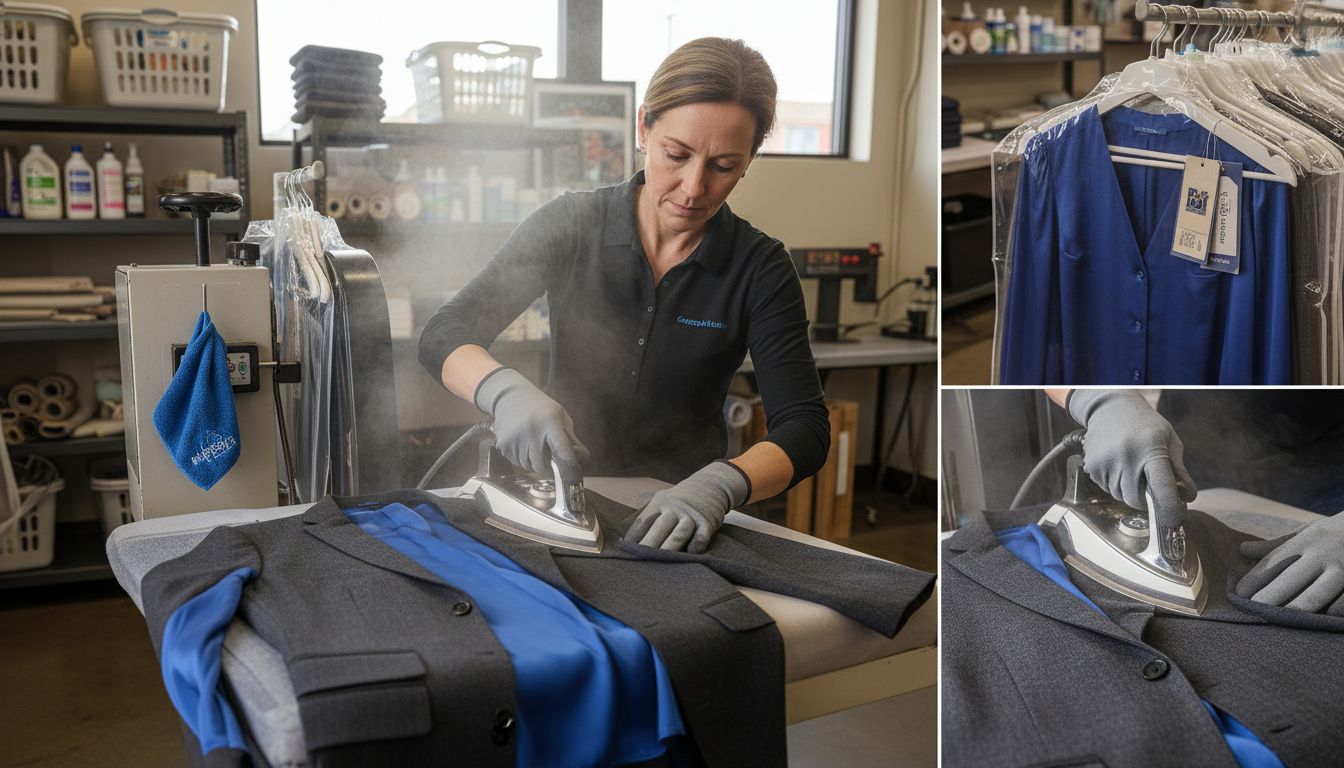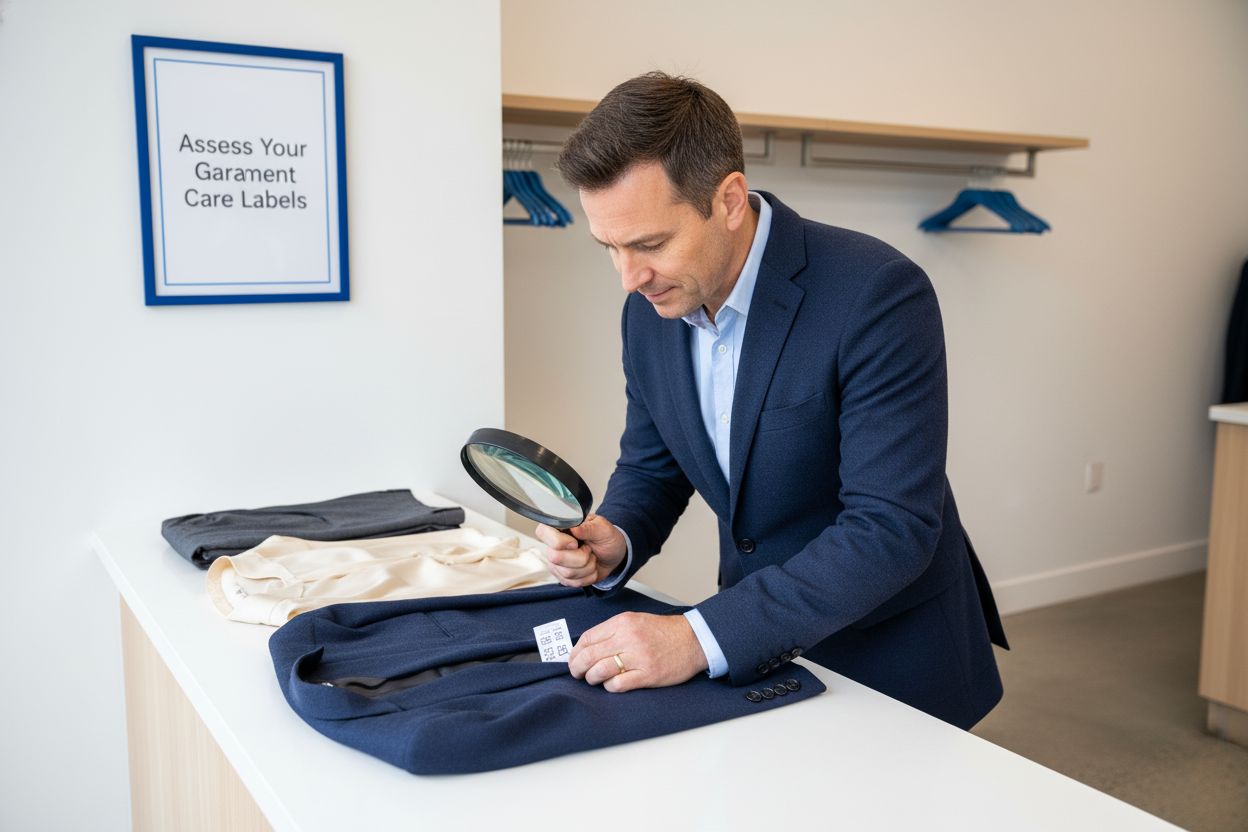Why Use Dry Cleaning: Complete Guide for Busy Lives

More than 80 percent of delicate garments are damaged by regular home washing, yet most people are unsure how to properly care for these items. Keeping your favorite silk dress or tailored suit looking sharp can feel impossible with everyday laundering. Understanding what dry cleaning is and how it works can help you protect your wardrobe, prevent fabric damage, and get that crisp, professional finish every time.
Key Takeaways
| Point | Details |
|---|---|
| Specialized Cleaning Method | Dry cleaning uses chemical solvents, primarily perchloroethylene, to thoroughly clean delicate garments without water, preventing damage and preserving quality. |
| Suitable Fabrics | Best suited for natural fibers and intricate clothing, including suits, silk, and designer items that require special care to avoid damage. |
| Benefits of Professional Services | Offers superior stain removal, fabric preservation, and expert finishing, significantly extending the lifespan of high-quality garments. |
| Misconceptions | Common myths about dry cleaning include its perceived high cost and misunderstanding of the cleaning process, which is not completely dry but relies on liquid solvents. |
What Dry Cleaning Is and How It Works
Dry cleaning is a specialized fabric care process that uses liquid solvents instead of water to remove stains and clean delicate garments. According to clu-in, the process involves treating spots manually, then tumbling clothes in machines with specific solvents and detergents, which efficiently remove dirt and grime without water’s potential fabric damage.
Unlike traditional washing, dry cleaning uses chemical solvents—most commonly perchloroethylene—which can penetrate fabric fibers more deeply than water. This technique is particularly effective for:
- Suits and formal wear
- Silk and wool garments
- Clothing with complex embellishments
- Delicate fabrics that might shrink or degrade in water
The typical dry cleaning workflow includes several precise steps. First, garments are carefully inspected for stains, which are pre-treated by hand. Then, clothes are placed in specialized cleaning machines that use solvent cycles to remove dirt. clu-in notes that used solvents are actually distilled and reused, making the process more environmentally conscious than many people realize.
After cleaning, clothes undergo careful pressing and finishing to ensure they look crisp and well-maintained.
 For busy professionals and families, dry cleaning offers a convenient solution to maintaining high-quality garments without the time-consuming and potentially damaging process of home laundering.
For busy professionals and families, dry cleaning offers a convenient solution to maintaining high-quality garments without the time-consuming and potentially damaging process of home laundering.
Types of Items Best Suited for Dry Cleaning
According to iloencyclopaedia, dry cleaning is specifically designed for fabrics that are sensitive to water and prone to damage, shrinkage, or color loss. This makes it an essential service for preserving delicate and high-value clothing items that require special care.
Natural Fiber Garments are particularly well-suited for dry cleaning, including:
- 100% Wool suits and blazers
- Silk dresses and blouses
- Cashmere sweaters
- Fine linen clothing
- Delicate vintage or designer pieces
Beyond natural fibers, dry cleaning is crucial for garments with complex construction or intricate details. The Role of Dry Cleaning for Busy Lives highlights that items like wedding gowns, suits with intricate tailoring, and clothing with delicate embellishments like sequins or beading require professional cleaning techniques to maintain their original quality and appearance.
Professional dry cleaning also extends to specialized items that home laundering might damage. This includes structured garments like tailored jackets, pleated skirts, leather and suede accessories, and uniforms with specific maintenance requirements. By choosing professional dry cleaning, you’re not just cleaning clothes—you’re investing in preserving the longevity, shape, and appearance of your most valuable wardrobe pieces.
Benefits of Professional Dry Cleaning Services
According to iloencyclopaedia, professional dry cleaning effectively removes stains and soils while preserving the delicate texture and color of garments. This specialized cleaning method goes far beyond what traditional home laundering can achieve, offering a comprehensive solution for maintaining high-quality clothing.
The cleaning process offers multiple significant advantages:
- Superior stain removal
- Fabric preservation
- Color retention
- Professional pressing and finishing
- Extended garment lifespan
Cleaninginstitute explains the scientific approach behind professional dry cleaning, which combines chemical, mechanical, and thermal energies to dissolve stains and loosen dirt. This multi-dimensional cleaning approach ensures that garments are not just cleaned, but meticulously restored to their original condition.
Master the Professional Dry Cleaning Process Today highlights that professional services offer more than just cleaning—they provide comprehensive garment care. From intricate tailoring to delicate fabric maintenance, dry cleaners use specialized techniques that protect your investment, ensuring your clothing looks pristine and maintains its original shape, texture, and quality.
Comparing Dry Cleaning to Home Laundering
According to clu-in, dry cleaning fundamentally differs from home laundering by using specialized solvents instead of water to clean fabrics. This critical distinction prevents common laundering problems like shrinkage, dye bleeding, and fabric distortion that typically occur with traditional washing methods.
Key differences between dry cleaning and home laundering include:
- Cleaning Solution: Solvents vs. water
- Fabric Handling: Specialized machinery vs. home washers
- Stain Treatment: Professional spot removal vs. generic washing
- Garment Preservation: Minimal fabric stress vs. potential damage
- Finishing: Professional pressing vs. home ironing
News highlights emerging alternatives like wet cleaning, which uses biodegradable detergents and water. However, this method remains less effective for delicate or specialty fabrics that require precise cleaning techniques. 7 Key Differences: Dry Cleaning vs Wash and Fold Explained emphasizes that professional dry cleaning offers a level of care and expertise that home laundering simply cannot match, especially for high-value or delicate garments that require specialized treatment.
Cost, Convenience, and Common Misconceptions
Iere reveals that dry cleaning is often misunderstood, particularly regarding its cost and process. While many perceive professional dry cleaning as expensive, the service actually provides critical value by preserving delicate garments that would otherwise be damaged by traditional home laundering methods.
Common misconceptions about dry cleaning include:
- Cost Myth: Expensive service with no real benefit
- Process Misunderstanding: Believing it’s completely “dry”
- Fabric Safety: Assuming all garments can be dry cleaned
- Environmental Concerns: Thinking the process is harmful
- Time Investment: Believing it’s inconvenient and time-consuming
Toronto Environment clarifies a crucial misunderstanding: dry cleaning isn’t actually “dry” at all, but uses liquid chemical solvents instead of water. This nuanced cleaning approach means that while the process isn’t water-based, it’s far from being a completely dry procedure. How long does dry cleaning take highlights that modern dry cleaning services have streamlined their processes, offering quick turnaround times that make professional garment care more convenient than ever before. The investment in dry cleaning isn’t just about cleaning—it’s about extending the life and maintaining the quality of your most valuable clothing items.
Experience the Ease and Care of Professional Dry Cleaning
Busy lives demand smart solutions for maintaining your wardrobe, especially when delicate fabrics or special garments require expert care. The challenge of preserving the longevity and look of your clothing without sacrificing time or quality is exactly why professional dry cleaning matters. From stain removal to fabric preservation and flawless finishing, relying on a trusted service ensures your clothes look their best with minimal effort on your part. Columbia Pike Laundry understands these needs and combines expertise with convenience to give you peace of mind.
Discover how our in-house cleaning processes and customized options can protect your investment in quality garments. Whether you have silk, wool, or intricate outfits that need special attention, our team handles cleaning with precision and care. Learn more about our approach and fabric care techniques at Fabric Care Expertise | Laundry Tips and explore the details of our Dry Cleaning | Laundry Tips to see why professional cleaning outperforms home laundering.

Ready to reclaim your time and protect your wardrobe with expert dry cleaning? Visit Columbia Pike Laundry today to schedule your pickup or drop-off. Take advantage of our reliable, fast turnaround and personalized service to keep your garments in pristine condition now.
Frequently Asked Questions
What is dry cleaning and how does it work?
Dry cleaning is a specialized cleaning process that uses liquid solvents instead of water to remove stains and clean delicate fabrics. The garments are pre-treated for stains, then cleaned in machines with specific solvents that penetrate deep into fabric fibers, ensuring effective cleaning without the risks associated with water.
Why is dry cleaning recommended for certain fabrics?
Dry cleaning is particularly effective for natural fibers like wool, silk, and cashmere, as well as garments with intricate details or embellishments. These fabrics are sensitive to water, making dry cleaning a safer choice to prevent damage, shrinkage, or color loss.
What are the benefits of using professional dry cleaning services?
Professional dry cleaning services provide superior stain removal, fabric preservation, and color retention. They also offer professional pressing and finishing, ensuring garments maintain their original shape and appearance while extending their lifespan.
How does dry cleaning compare to home laundering?
Dry cleaning uses specialized solvents and equipment, which prevents issues like shrinkage and dye bleeding that often occur with home laundering. Additionally, dry cleaning offers professional stain treatment and minimizes fabric stress compared to traditional washing methods.

Recommended
Popular Blog Articles

Meet the Author
Daniel Logan didn’t start CPL because he loved laundry. He started it because his family was drowning in time debt, and laundry was one of the biggest weights.
Mornings were chaos with two kids under 5. Evenings felt like catch-up. And weekends? Gone to sorting socks and folding piles.
He knew his story wasn’t unique. So he built a business that gave families like his just a little bit of breathing room one load at a time.
With no laundry experience but deep tech skills, Daniel rolled up his sleeves, doing every job himself while building systems that turned it into a modern laundry service that saves customers time, simplifies their lives, and delivers reliability they can count on.
That’s where CPL began. Not from a playbook, but from pain. From one dad trying to buy back time: for himself, and for every household like his.





